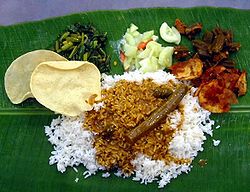Banana leaf platter
Thank you for being part of the Bharatpedia family! 0% transparency: ₹0 raised out of ₹100,000 (0 supporter) |
This article needs additional citations for verification. (February 2013) |
 Banana leaf rice | |
| Place of origin | India |
|---|---|
| Region or state | South India Southeast Asia |
| Main ingredients | Rice, curry, banana leaf |
Banana leaf platter is a traditional method of serving rice dishes in South Indian cuisine.[1] Due to the migration of South Indians, banana leaf rice can also be found in areas with significant ethnic South Indian diaspora such as Malaysia and Singapore.
In banana leaf meals, white rice (or parboiled rice in authentic South Indian restaurants) is served on a banana leaf with an assortment of vegetables, pickles, appalam and other regional condiments (usually sour, salty or spicy). The banana leaf acts as a disposable plate and it in itself is not consumed. The choice of banana leaves is mainly due to the broad leaves as well as to the ubiquity of the plant in South India. Typically, only vegetarian gravy (e.g. sambar) will be served on the rice as it is meant to be a traditional vegetarian dish. However, sometimes boiled eggs, curried or fried meat or seafood are served as well. Traditionally, there will be two servings of rice with the first being served with gravy, side dishes and condiments whilst the second serving will be just rice with curd as a palate cleanser.
Banana leaf meals are eaten by hand. Traditionally only the right hand is used, and only the tips of the fingers should touch the food. Any part of the finger beyond the first knuckle or the palm must not touch the food. Parts of the Banana leaf meal etiquette also dictates that, after the meal, the guest must always fold the banana leaf inwards as a sign of gratitude to the host, even when the host is the proprietor of an eatery. However, when meals are served at funeral wakes, the leaf is folded outwards as a sign of condolence to the family of the deceased. Due to this, folding the leaf outwards is considered rude in any other circumstance.
References
- ↑ "Archived copy". Archived from the original on 22 May 2009. Retrieved 9 May 2009.
{{cite web}}: CS1 maint: archived copy as title (link)
